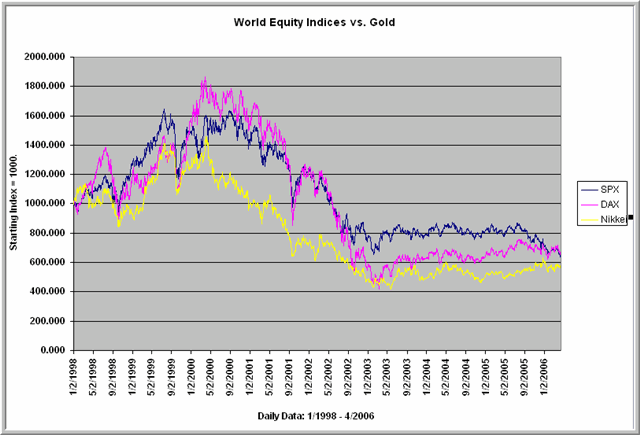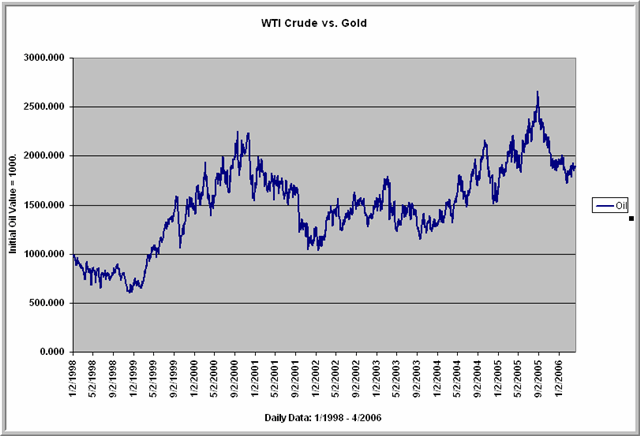The difference between Gold and Dollars
Traders live in a numerator world. Stocks fall. Gold rises.
Bonds dip. Oil soars. Every day we contemplate market moves, and we
measure them against a common yardstick. That yardstick–our typical
denominator–is the dollar. Each index, commodity, and equity value that
we follow is really a spread position, if you think about it. When we buy
a stock, we are selling dollars. When we short a stock, we’re taking
dollars in return for our sale of the shares. We buy if we think an
instrument will outperform the dollar. If we don’t have that belief, we
either hold our dollars or actively sell the instrument to take delivery of more
dollars.
But, ah, what a difference a denominator makes. There was a time–not
so long ago–when every dollar was denominated in gold. Under the gold
standard, you could redeem your greenback at any time for a fixed quantity of
the precious metal. The idea was that gold, as a universal store of value,
would impose discipline upon governments who, otherwise, might be tempted to
artificially inflate their wealth by printing currency. After all, if you
have a fixed amount of gold in your reserves and every dollar must be backed by
a piece of that gold, you have limits to the currency you can print.
Just as a little exercise, let’s return to that bygone era and imagine that
an ounce of gold is our denominator. Instead of measuring trading
performance against dollars (which rise and fall with the exigencies of printing
presses, interest rates, and the like), let’s use the precious metal as our
yardstick. What would our financial world look like today?
Below are the results for three major world stock indices since January,
1998. For ease of comparison, I set the initial value of each index at
1000. As you can see, all three indices have lost value in the past eight
years. Indeed, the S&P 500 Index–which has been broaching bull market
highs in dollar terms–is actually making multiyear lows vis a vis our universal
store of value.

What is apparent from the chart is that concern over whether you
have been weighted in American, German, or Japanese stocks has meant relatively
little compared to the overall weakness among all of them. In fact, the
bull market since 2003 has barely budged the averages in gold terms.
And how about that stellar performer, oil? How has it
fared vis a vis the changed denominator? Below I’ve charted the same time
period, again setting the initial value of West Texas Intermediate crude to
1000.

Sure enough, it’s still a bull market–which tells us that oil’s
price strength is not simply an artifact of dollar weakness.
But, wait a minute. It’s not just dollar weakness.
Since January, 1999, the Euro has risen only about 2.5% versus the dollar.
The Yen since January, 1998 has appreciated relative to the dollar by about
11.9% on the cash market. These hardly offset the effect of changing
denominators. Just as the world equity indices are down vs. gold, so are
the world’s currencies.
What can we make of this? Quite simply this:
Financial
assets are being trounced by hard assets. Relative to commodities (like oil and gold), bonds, stocks, and currencies are in major
declines. Yes, we can say there is a commodity boom. Another way of
looking at it, however–one that used to represent economic orthodoxy–is that
financial assets are no longer adequately serving as storehouses of value.
Now suppose in this situation, I were to approach you and say,
“Hey, forget about those hard assets. Give me your 1000 dollars today
and I’ll give you even more dollars ten years down the road.” How
many dollars would you need to make that deal worthwhile, especially as you see
dollars–and dollar denominated assets–buying less and less of the world’s
things? Chances are, you’d have to receive quite a rate of return on your
dollars to offset the opportunity risks of putting your money into
“things“. And as dollars and stocks fell more and more against
those things, you’d need better and better terms to justify committing your
funds to those financial assets. You’d demand higher interest rates, and
you’d demand higher dividends and earnings yields (earnings per dollar of stock
price). So bonds and stocks would continue to fall until they represented
real value relative to those competing “things“.
What a difference a denominator makes.
Brett N. Steenbarger, Ph.D. is Associate Clinical
Professor of Psychiatry and Behavioral Sciences at SUNY Upstate Medical
University in Syracuse, NY and author of The
Psychology of Trading (Wiley, 2003). As Director of Trader Development
for Kingstree Trading, LLC in Chicago, he has mentored numerous professional
traders and coordinated a training program for traders. An active trader of the
stock indexes, Brett utilizes statistically-based pattern recognition for
intraday trading. Brett does not offer commercial services to traders, but
maintains an archive of articles and a trading blog at www.brettsteenbarger.com
and a blog of market analytics at www.traderfeed.blogspot.com.
His book, Enhancing Trader Development, is due for publication this fall
(Wiley).
